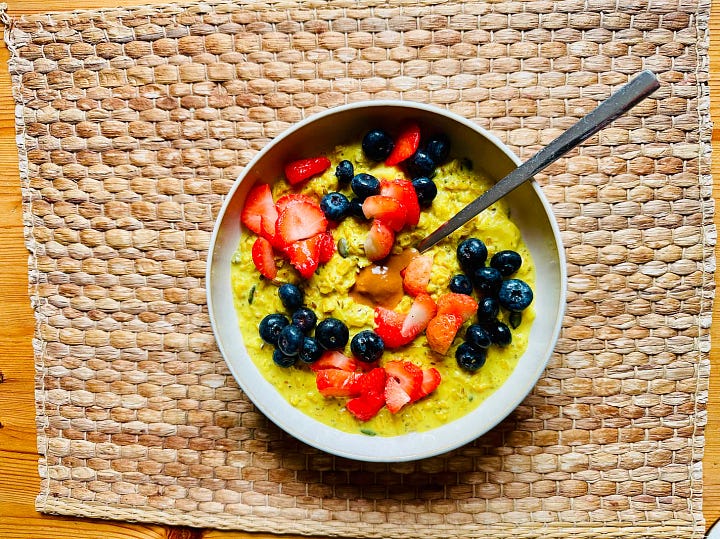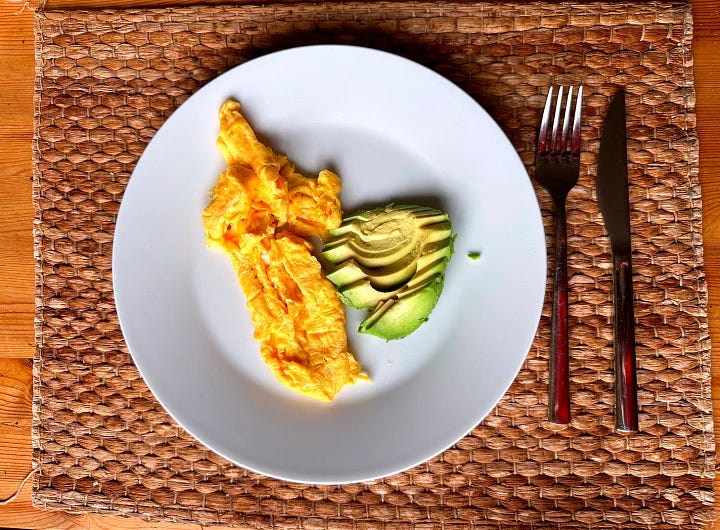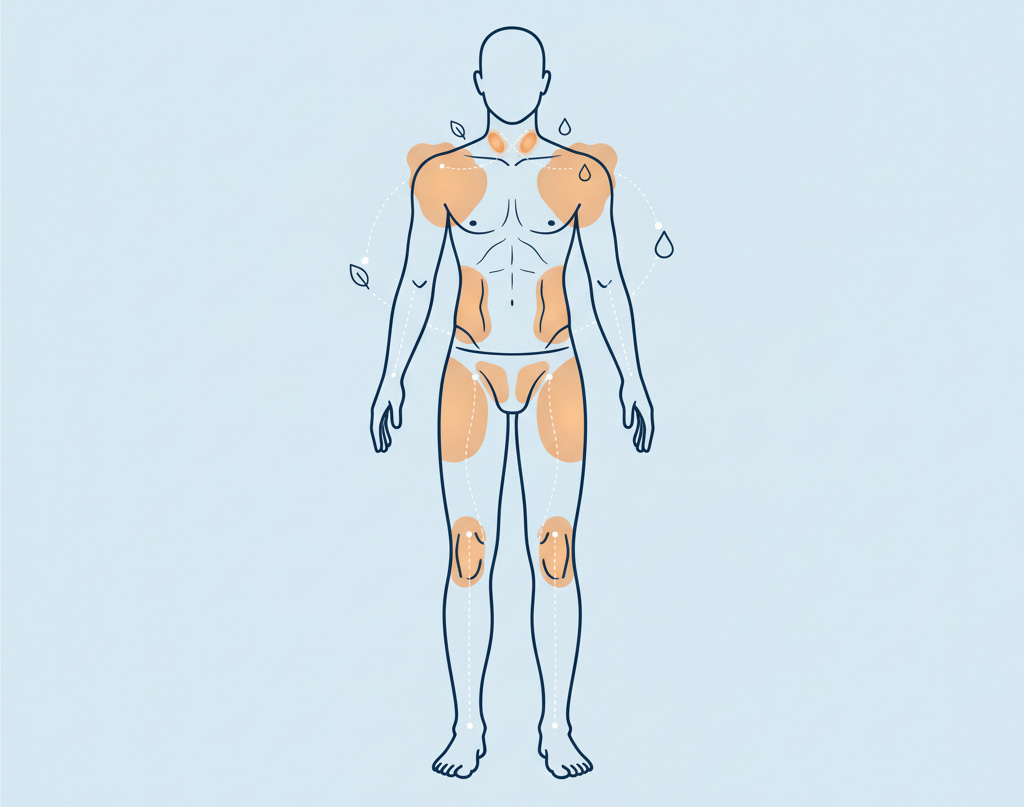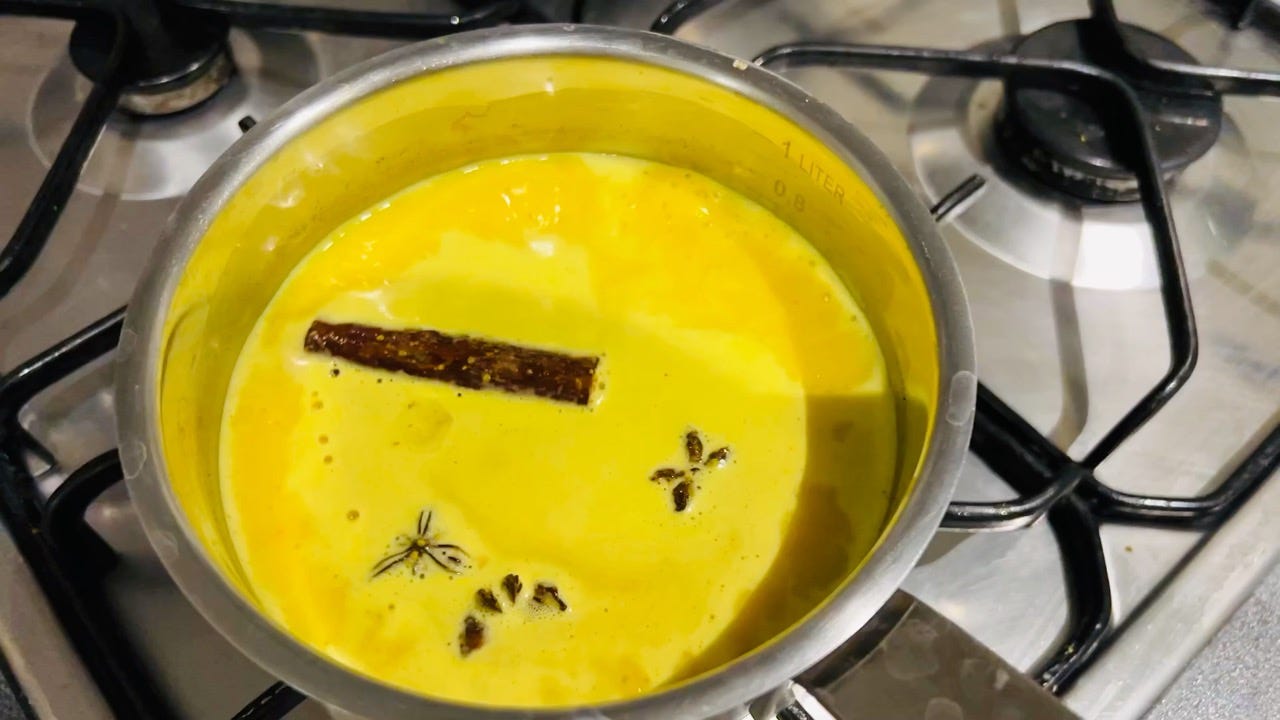Autumn cold adaptation for better sleep & steadier glucose (without the ice baths)
A gentle 7-day ramp: tiny cold doses, warm protein breakfasts, and lamp-lit evenings.
Being unwell for the past two weeks slowed me down enough to notice something obvious: autumn had moved in, and my body was updating its settings, whether I gave it permission or not.

1. Autumn’s first chill: your body’s cue to cold adaptation
Since late summer, I’ve been in observation mode.
As the outer clock (daylight length) started contracting, and mornings grew cooler on my skin, I noticed how my inner clock (temperature, cortisol, appetite) started responding [1].
But when the temperature suddenly dropped from 24°C to 12°C last weekend, I felt wrecked. With a decisive voice, my body demanded warm foods and energy conservation.
I realised this wasn’t a setback; it was intelligent design.
Metabolism wants and needs seasonal change [3]. This builds adaptability and flexibility, enabling the body to thrive in different conditions and allowing the system to renew itself.
So, when the external clock changes and your internal one is listening, what do you actually do?
You turn the chill into skill with two moves: a tiny cold dose and a warm, protein-first bowl.
2. From chill to skill: The 7-day adaptation playbook
That shiver we all find annoying when it gets cold? It isn’t body failure, it’s a system check.
If cold is the push notification, then the shiver is “Update now.” Press it and BAT (brown adipose tissue) [2], the hardware responsible for cold adaptation [3], begins to do its job.
Here’s how to use that cue.
For the next 7 days, run this simple pairing: one tiny cold dose followed by one warm anchor.
Morning
Brisk, cool walk (10–12 minutes) with sunlight.
No time to get out? Crack the windows open for 3–10 minutes and let the fresh, cool air flood your room, letting sunlight hit your retina
Re-warm: a hot mug of tea, warm socks, then 2 minutes of easy mobility..Face & neck cold splash (10–30 seconds, 2–3 rounds).
It feels sharp at first, but becomes easier by day three as your body adapts.
Re-warm: Rinse with warm water, then use the hot mug and mobility sequence.(Optional) Cool-finish shower (30–60 seconds) if that’s your easiest route and you shower in the mornings.
Breakfast
Eat a warm, protein-first breakfast (recipes below).
Use the steadying formula: protein + fibre + fat + an acid (such as lemon drizzle or greens).
Examples: eggs + 1/2 avocado before porridge; savoury oats finished with lemon; stewed fruit + cottage cheese with mixed seeds.
Evening (bonus worth doing)
Dim lights after 8 pm—overheads off [1]. Catch the earlier sleep wave.
Why this works: the tiny cold dose from the walk recruits brown fat and vascular control; the warm, protein-first breakfast tells your body “you’re safe.” Together, they turn that first shiver into adaptation, not a sugar hunt.
Tweak for real life: skip cold on illness/low-sleep days. Late-luteal or extra cold-sensitive? Swap the cold for heat (bath/sauna blanket/hot-water bottle) and keep the rest.
Tried any of these? Comment AUTUMN+10 with your Day-7 takeaway.
3. Cold Adaptation & Brown Fat, Explained
A while back, I wrote this article on heat/cold exposure, which briefly mentioned BAT (brown adipose tissue). BAT is the mitochondria-rich fat that can burn fuel as heat and is key to cold adaptation.
Cold adaptation is how your body learns to generate heat with less panic (shivering) and more non-shivering thermogenesis (NST). With repeated mild cold, shivering drops, comfort rises, and heat output is shared by BAT + skeletal muscle. You acclimate [2]; cold days feel less like an argument.
What’s happening physiologically
Short, consistent cool cues (morning air, a brief cool rinse) tell your system, “winter is coming.” Vessels become more efficient at directing blood flow, and BAT becomes more readily available to generate heat. Over days, you rely less on shaking and more on NST. That’s the feeling of being okay outside without immediately wanting to go back and cranking the thermostat or eating sugar to stay warm.
Why BAT matters (and where not to overhype it)
Thermal comfort & energy. Repeated cool signals recruit/activate BAT and sharpen blood-flow control. You feel less rattled by cold snaps and steadier while you’re out in them.
Glucose & insulin sensitivity. In small human trials, ~10 days of mild cold improved insulin sensitivity [4], particularly in metabolically challenged groups.
Acute reality check. On Day 1, most heat still comes from shivering and general metabolic work [5]; with practice, the balance shifts toward NST (BAT + muscle doing more of the lift).
Mood & timing assist. A brief cold hit raises norepinephrine (alertness). Pair morning cold with morning daylight, then dimmer evenings, to support the serotonin→melatonin handoff and help sleep arrive earlier.
How researchers dose it (context, not a prescription)
Classic lab protocols look like ~10 days at 14–16°C, 1–2 hours/day, staying just shy of shivering. Your home version is gentler: seconds to minutes of cool + full re-warm, every morning for a week.
How you’ll know it’s working (real-life signs)
You shiver less in the same weather than you did on Day 1.
Cool finish or window breaths feel more tolerable by mid-week.
The “I need sugar to feel warm” urge is quieter before lunch.
Bedtime drifts earlier when you keep lamps after 8 pm.
Ready to feed the adaptation? Let’s build breakfasts that warm you without the glucose crash.
4. Comfort without the crash: Two warm, protein-first bowls to support the changes your body is going through
I know, I know. Porridge gets a bad rep. But that’s because, eaten by itself, it does spike your glucose. However, there are a few tricks to make it not only glucose-friendly but also super nutritious and filling.
First, I always pair it with fibre, good fats, and protein, so that it keeps me full and is glucose-friendly [6].
Second, I use spices that have anti-inflammatory properties and help with cold adaptation.
So I’ll share two recipes I like to use in the cold season that keep me balanced and full.
1. Turmeric latte spiced porridge.


Serves: 1 | Time: 15–18 min
Ingredients
1 cup of almond milk /other milk of choice (250 ml)
5-6 tablespoons of oats
1/2 teaspoon of turmeric latte mix ( see recipe below)
1 pinch of salt
1 pinch of pepper (to activate the curcumin in the turmeric latte mix)
1 anise star
2 small cardamom pods
1 tablespoon of seed mix (chia, hemp, flax, pumpkin)
1 small banana (optional for sweetness)
Fresh or frozen berries to top
Protein side before the porridge: simple omelette or two soft-boiled eggs + ½ avocado
Method
Add the milk and oats to a pot and let them sit for 5 minutes to absorb some of the liquid and soften slightly. (This step is important as it helps create a creamier porridge and reduces cooking time.)
Place the pot over low to medium heat, add the spices, salt, pepper, and latte mix, and bring to a boil. Once boiling, simmer for about 10-12 minutes, stirring constantly to prevent the porridge from burning.
When the porridge is nearly done, add the seeds and banana, if using. Let the mixture simmer for an additional 3 minutes before removing it from the heat.
Transfer to a bowl and top with fresh or frozen berries of your choice (I usually use a mix of blueberries, raspberries, and kiwi).
While the porridge cools slightly, you have two options: either prepare a simple omelette or two soft-boiled eggs with half an avocado, which you should eat before your porridge.
Why it works: This warm, protein-forward, fibre- and mineral-rich blend (seeds + latte mix) combined with eggs and avocado ensures a steady glucose level and keeps you full for at least 4-5 hours.
Turmeric Latte Mix
Ingredients (makes ~10 servings)
3 tbsp ground turmeric
2 tbsp ground ginger
1 tbsp cinnamon
1 tsp ground cardamom (optional)
1/2 tsp ground black pepper ( for curcumin bioavailability boost)
Method
Whisk to combine. Store airtight. Use 1/2 tsp per serving; adjust pepper to taste.
2. Savoury Oat-Eggs Bowl (stock, greens, lemon)
Serves: 1 | Time: 12–15 min
Ingredients
50 g jumbo or steel-cut oats
300 ml stock (chicken or veg), plus a splash of water if needed
2 eggs, soft-boiled or poached
80–100 g mushrooms, sliced
1 big handful spinach (or chopped chard)
1 tsp ghee/butter
Pinch salt + black pepper
Finish: lemon wedge + chopped parsley
Method
Over medium-high heat, sauté the mushrooms in ghee/butter with a pinch of salt until they are browned.
Stir in oats and stock; simmer until creamy and tender, about 10-12 minutes.
Fold in the spinach to wilt.
Reduce the heat to low.
When it’s cooked through, transfer to a bowl and add the soft-boiled or poached eggs on top, half an avocado sliced, and a few halved cherry tomatoes.
Finish with black pepper, lemon, and parsley.
Why it works: warm, protein-forward, mineral-rich (stock + greens), with acid to keep the curve flat—perfect partner to tiny morning cold doses.
As always, thank you for reading Salt, Pepper, Stories. If this post helped you, please give it a heart, comment, or share. We grow when friends tell friends.
Until next time.
xx, Ana
[1] Light timing (AM advances, PM delays; screens at night). https://pmc.ncbi.nlm.nih.gov/articles/PMC4344919/
[2] Cold acclimation recruits BAT & increases non-shivering thermogenesis (NST).
https://www.jci.org/articles/view/68993?
[3] Brown fat thermogenesis and cold adaptation in humans
https://pmc.ncbi.nlm.nih.gov/articles/PMC12010580/
[4] Short-term cold acclimation improves insulin sensitivity in patients with type 2 diabetes mellitus
https://pubmed.ncbi.nlm.nih.gov/26147760/
[5] Shivering thermogenesis in humans: Origin, contribution and metabolic requirement
https://pmc.ncbi.nlm.nih.gov/articles/PMC5605160/
[6] Protein/veg → carbs meal order blunts post-meal glucose.
https://diabetesjournals.org/care/article/38/7/e98/30914/Food-Order-Has-a-Significant-Impact-on?





